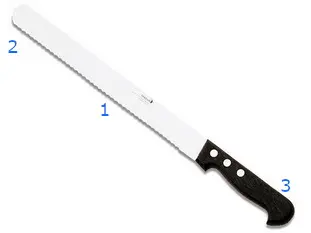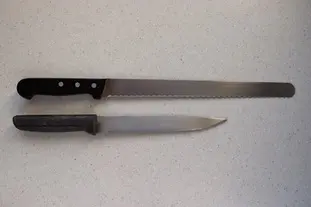This site uses only a few technical cookies necessary for its operation. By continuing to browse, you accept their use.
To find out more...
To find out more...
The right bread knife

We almost all have a bread knife in our kitchen, that is to say the knife we use almost exclusively to cut bread.
Is this knife efficient, is it really the one you need? Here is some information to guide you in your choice.
Is this knife efficient, is it really the one you need? Here is some information to guide you in your choice.
12 K
Keywords for this post:KnifeBreadSizeBladeCuttingSawLast modified on: September 15th 2022
The right bread knife

You really need a specific knife for that, and which has, if possible, the following characteristics.

1) A serrated blade
That is to say with teeth, we often say "saw knife", as opposed to a smooth blade, which allows an easier cutting of the bread.
You will sometimes read, here or there, that you should not "tear the bread crumb" with a serrated blade, but this is nonsense.
2) A long blade
This is the main defect of bad bread knives, their blade, although serrated, is not long enough to allow a good cutting. With a long blade, your gesture will be more ample, therefore easier, and the cut more regular.
3) A wide handle
It is absolutely necessary that you have a good grip on your knife, so that its handle is comfortable and well adapted to the size of your hand.
4) Practical materials
It is not an obligation, but your bread knife must be easy to use and maintain, which in my opinion implies both a stainless steel blade and an abs plastic handle or equivalent that does not fear water.
With all these criteria, it is quite simple to find the ideal knife, the choice is quite vast fortunately.
To make a long story short, the main defect you will encounter is a blade that is too short. I advise you to opt for a blade of 10 inches (25 cm) minimum.
You will easily find a lot of bread knives with a 8 inches (20 cm) blade, which certainly cut, but are much less efficient than a 25 cm blade.

The trick I suggest is to look for, or go to a professional store, and choose what they call a "sponge knife", which is a saw knife with all the criteria we just mentioned and a 11 inches (28 cm) blade.
You will be delighted with its efficiency, to easily cut from the smallest to the largest loaf, and to make even slices.
The next time you go to your bakery, look at the knife that the sales team uses to cut the bread for the customers, it is exactly this model.
To sum up: For your bread knife, you need a stainless, long (10 inches (25 cm) minimum) and serrated blade.
Lasts posts
Butter vs. grease
We often read in a recipe where a pastry is put into a mould that, just before pouring, the mould should be buttered or greased. But what's the difference between these 2 terms?December 1st 20259665
Getting out of the fridge early
Very often when you're cooking, you need to take food or preparations out of the fridge, to use them in the recipe in progress. There's nothing tricky about this: you just take them out of the fridge and use them, usually immediately, in the recipe. But is this really a good method?November 24th 20251,0955
Who's making the croissants?
When you look at a bakery from the outside, you naturally think that in the bakery, the bakers make the bread, and in the laboratory, the pastry chefs make the cakes. It's very often like that, with each of these professions having quite different ways of working, but sometimes there's also one...November 23th 2025991
Oven height
When we put a dish or cake in the oven, we naturally tend to put it on the middle shelf, and that's what we usually do. But in some cases, this position and height can be a little tricky, so let's find out why.October 8th 20252,7165
The importance of sieving
In recipes that use a fine powder (flour, powdered sugar, etc.), you'll often see the advice to sift before using it. To sift is to pass the powder in question through a sieve (a very fine strainer) before incorporating it into your recipe. It's often advice, but is it really useful?September 3rd 20257,5223
Other pages you may also like
Vitamin C against blackening
You've probably heard of this tip: to prevent fruit or vegetables from turning brown or black, simply add or sprinkle lemon juice over them. It's very effective, but why does lemon juice have this effect?July 14th 20239,908 15
The baker always gild twice
I've already told you about gilding, the beaten whole egg that is spread with a brush on anything that needs to brown in the oven: puff pastry, pastries, etc. and that professionals use a lot, I'm going to come back to this to clarify a bit how to do it, and give you a professional tip.June 9th 201935 K4.2
Let's rehabilitate spinach
We are currently (as I write this) in the season of fresh spinach, and it is a delicious vegetable that unfortunately has a bad reputation among a lot of people, children and teenagers in particular. I wonder if this lack of appetite isn't due to what I call, probably unfairly, "school food...May 7th 20218,1114.8
The return of the "Norman hole"
You maybe know the "trou normand", this old gastronomic custom typically French which consists in taking a (small) glass of calvados, generally between the last course and the dessert? It's something that seems a bit anachronistic nowadays, having a glass of an alcohol of more than 60° in the...December 18th 202115 K4.8
How to properly roll out a pie crust?
Very often in pastry making, you have to roll out a pastry before using it for a pie or another dessert. At home, of course, you get out your rolling pin and simply roll it out. Is there a way to get an evenly rolled out dough? That's what we will see in this article.May 10th 202310 K4.9
Post a comment or question
Follow this page
If you are interested in this page, you can "follow" it, by entering your email address here. You will then receive a notification immediately each time the page is modified or a new comment is added. Please note that you will need to confirm this following.
Note: We'll never share your e-mail address with anyone else.
Alternatively: you can subscribe to the mailing list of cooling-ez.com , you will receive a e-mail for each new recipe published on the site.









